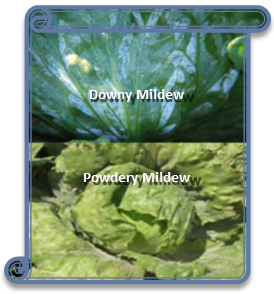
|
|
|
|

|
|||
|
|
|||
|
|
|||
|
This is the time during the lettuce production cycle in Yuma County that downy and
powdery mildew can both be present in the field. There are some straightforward
clues that will help identify which mildew disease is present. Symptoms. Spots or
lesions caused by downy mildew can first appear as one or more yellowish areas on
the upper leaf surface usually bordered by leaf veins, giving the affected portions
of the leaf a somewhat angular appearance. In time, these lesions will increase
in number and older ones will turn brown and necrotic. On the other hand, first
evidence of powdery mildew is the appearance of very small circular colonies of
the pathogen growing on the upper or lower lettuce leaf surfaces. Over time, these
colonies enlarge, produce spores that start new colonies, and eventually the entire
leaf surface can become covered with the powdery mildew pathogen. Spores. Spores
of the downy mildew pathogen (Bremia lactucae) usually arise from the underside
of leaves, are ovoid in shape, and are produced singly on the ends of branching
mycelium, much like fruit are borne on many types of fruit trees. Large numbers
of these spore-bearing

To contact Mike Matheron go to: matheron@ag.arizona.edu.
|
|||
| Back | |||
|
For questions or comments on any of the topics please contact Marco Pena at the Yuma Agricultural Center.
|
|||
|
Home |
Cotton | Veggies |
Forages | Grains
| Citrus |
Crop x Crop Insects | Diseases| Weeds | Pesticides | Economics | News | Weather | Research | Photos | Contacts | General Info. Copyright © 2001 University of Arizona, College of Agriculture and Life Sciences Webmaster: Al Fournier (acis@ag.arizona.edu) |
|||
